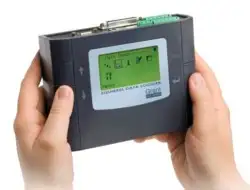Data Logger Explained

Electrical Testing & Commissioning of Power Systems
Our customized live online or in‑person group training can be delivered to your staff at your location.

- Live Online
- 12 hours Instructor-led
- Group Training Available
Download Our OSHA 3875 Fact Sheet – Electrical PPE for Power Industry Workers

- Follow rules for rubber gloves, arc-rated PPE, and inspection procedures
- Learn employer obligations for testing, certification, and training
- Protect workers from arc flash and electrical shock injuries
Data logger for electrical engineering applications, enabling data acquisition from sensors, high-resolution measurement, time-series recording, telemetry, calibration, and IoT monitoring for power quality, energy metering, equipment diagnostics, and load profiling.
Data Logger Overview and Best Practices
A data logger (or sometimes called a "datalogger") is a specialized electronic device that measures and records specific data over a certain period of time or in relation to its location either with a built-in instrument or sensor or via external instruments and sensors.
Datalogging is a term used to describe using a device to collect data through a sensor. That way, the data can be analyzed and saved and then the results can be output and the data collection and analysis performed. For teams integrating loggers into power systems work, a grounding in electrical testing concepts ensures proper sensor selection and safety.
A Data logger is commonly used in experiments and in data monitoring systems when there is a desire to harvest information faster than a human being can possibly collect the information, especially when the accuracy of the data is important. When verifying signals during setup, pairing a logger with a handheld DMM and reviewing how to use a digital multimeter can improve measurement accuracy and troubleshooting efficiency.
A Data logger varies between most general-purpose types of equipment for use in a range of measurement situations, to a very specific use in measuring one specific environment. It is most commonly used for general purpose applications. However, data loggers may remain as static devices with only a limited number of changeable parameters. In many data logging situations , electronic type dataloggers have mostly replaced chart recorders. In facilities where legacy panels are common, an analog multimeter can provide immediate spot-checks that complement long-duration logger trends.
Sign Up for Electricity Forum’s Test Equipment Newsletter
Stay informed with our FREE Test Equipment Newsletter — get the latest news, breakthrough technologies, and expert insights, delivered straight to your inbox.
A Data logger collects detailed information from an electronic sensing instrument over an exact period of time, usually performed at predetermined intervals.
There are various examples of the kind of information a data logger can collect, including: temperature, sound frequency, vibration, time, light intensity, electrical current, pressure. When capturing electrical parameters, confirming conductor integrity with a megohmmeter helps ensure safe and reliable measurements.
Data logger applications include: specific conditions like a warehouse, a production room, a refrigerator, a freezer, or a sterilizer. For troubleshooting compressed air leaks or partial discharge near monitored equipment, correlating events with acoustic imaging can pinpoint sources more quickly.
A Data logger may be used as a stand-alone configuration or it can be connected to a computer. Before integrating a logger with energized circuits, pre-commissioning with an insulation resistance tester reduces the risk of nuisance faults during runs.
A Data logger can record temperature, which is usually recorded by a thermocouple, a thermistor, or a resistance temperature detector (RTD)
A Data logger may be configured to include: wiring, multiple channels, or by self-contained instruments
For multi-channel deployments on motors or switchgear, checking insulation resistance of connected assets is a prudent preventive step.
A Data logger can be calibrated to an appropriate tolerance. However, the calibration should be National Institute of Standards and Technology (NIST) traceable.
A Data logger can be used to qualify environmental chambers, steam sterilizers, warehouses, and other controlled environments
Remember, when using a data logger, proper probe placement is an essential aspect of data collection.




